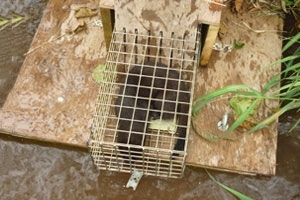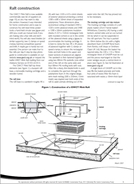 Mink control involves trapping and killing mink. Orders made under the Destructive Imported Animals Act 1932 make it illegal to keep mink without a licence, and stipulate precautions that must be taken to prevent escape. This legislation, therefore, also prohibits you from keeping, transporting or releasing a mink once you have caught it. So besides rafts, you will need traps and equipment for humane dispatch.
Mink control involves trapping and killing mink. Orders made under the Destructive Imported Animals Act 1932 make it illegal to keep mink without a licence, and stipulate precautions that must be taken to prevent escape. This legislation, therefore, also prohibits you from keeping, transporting or releasing a mink once you have caught it. So besides rafts, you will need traps and equipment for humane dispatch.
Two kinds of trap are allowed by law: live-capture traps (cage traps) and spring traps (killing traps). On balance, we recommend the use of live-capture traps in most circumstances. Live-capture traps seem intuitively humane to most people, though actually their relative humaneness compared with good spring traps is not beyond argument. The humaneness of confinement in a wire cage for up to 24 hours is one issue, and the competence of the operator to dispatch the mink humanely when discovered is another (see next section). A more clear-cut advantage is that live capture traps usually allow any non-target captures to be released alive and unharmed. Because non-target captures are so drastically reduced through the use of GWCT Mink Rafts, this is a minor issue in ecological terms, but there are legal complications (unclear aspects of the Wildlife & Countryside Act that have not been resolved through case law), and most operators prefer not to take the risk. With live-capture traps, you will also need a weapon to dispatch the mink.
There are two basic types of live-capture trap: single entry and double entry. The double entry type allows the mink to enter from either direction and presents no visible mesh barrier across the tunnel end when the trap is set. Although that may seem advantageous, double entry types have more mechanism to go wrong, tend to be skimpy in length between treadle plate and door, and would require a larger raft than we use. So on balance we prefer the single entry type. Field experience shows that mink have no trouble finding the entrance. Some traps have otter guards built in (see FAQs).
Some operators choose to pack hay or similar material around live-capture traps to provide captive animals with both insulative bedding material and a diversionary activity. Two problems can arise. Firstly, vegetation dragged into the trap may hinder the use of trap combs, which are crucial to the humane dispatch of mink with an air pistol. Secondly, an oversized tunnel is necessary. Once bedding material is drawn into the trap, the trap becomes a loose fit in the tunnel. Unless the trap is fastened to the raft, it is then possible for a captive mink to shuffle the trap out of the tunnel and off the raft, resulting in death by drowning and probably a lost trap.
Spring traps are cheaper and easier to transport than live-capture traps. They may be appropriate for an operator running only one or two rafts, for whom the expense and responsibility of owning a weapon and carrying out humane dispatch seems disproportionate. Spring traps may also have a role in catching ‘trap-shy’ mink. A list of trap models approved for mink can be found in the relevant Spring Traps Approval Order. Note that approvals differ slightly between England, Wales, Scotland and Northern Ireland.
Although approvals are supposedly based on an assessment of humaneness, we suggest that most of the traps currently approved for mink in the UK are underpowered. Among those currently approved for mink, we recommend only the Kania 2000 and 2500, and the DOC250. These models reliably strike the head with enormous force, instantly destroying the brain.
Under wildlife legislation in all devolved administrations it is expected that the trap operator will take reasonable precautions to avoid capture or injury of protected species, including all birds, otter and polecat.
Get your FREE Mink Raft Plans today
 The award-winning GWCT Mink Raft was developed both as a means of detecting mink, and as a favourable trap site.
The award-winning GWCT Mink Raft was developed both as a means of detecting mink, and as a favourable trap site.
What you can download for free
✓ Mink Raft Guidelines
✓ Instructions & Plans
✓ How to Build the GWCT Mink Raft
Download now >